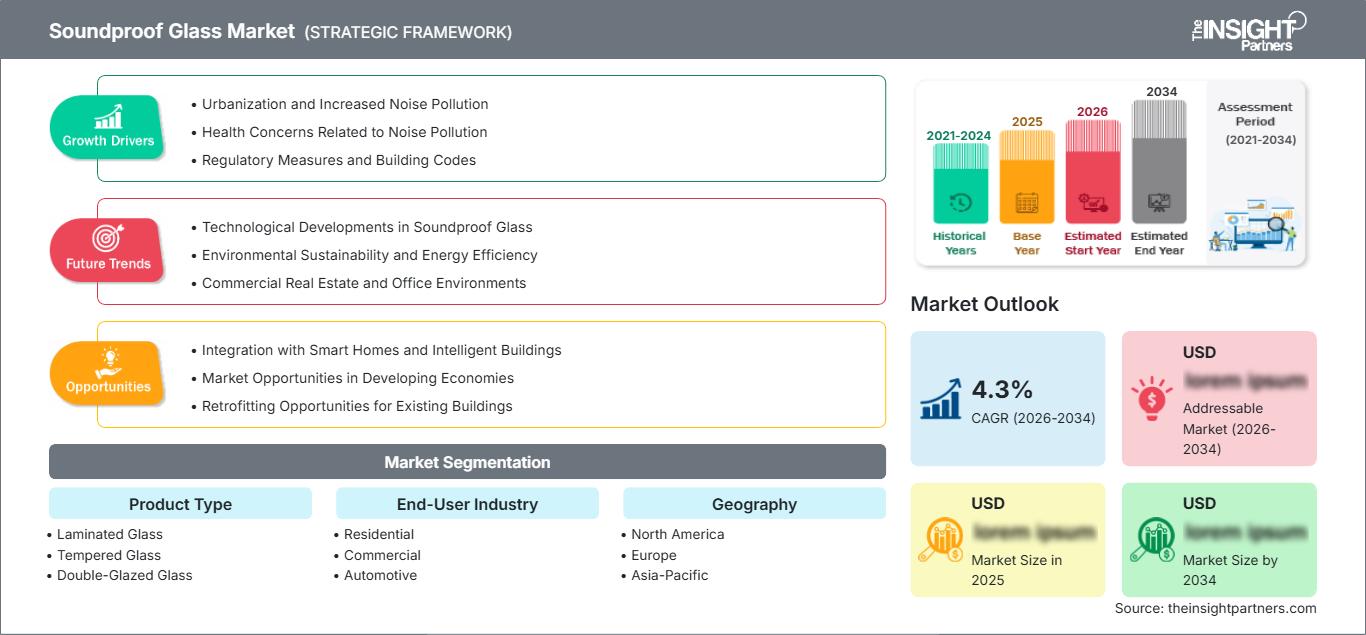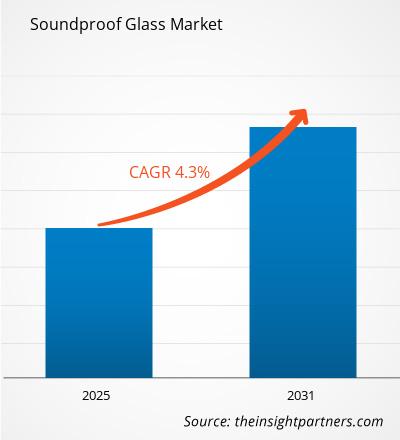방음 유리 시장은 2026년부터 2034년까지 연평균 성장률(CAGR) 4.3%로 성장할 것으로 예상됩니다. 시장 상황은 지속적으로 변화하며 이해관계자들에게 새로운 기회를 제공합니다. 전반적인 전망은 안정적인 성장세와 장기적인 성장 잠재력을 보여줍니다.
본 보고서는 제품 유형(접합 유리, 강화 유리, 이중 유리, 삼중 유리, 차음 유리)별로 세분화되어 있습니다. 또한, 최종 사용자 산업(주거용, 상업용, 자동차용 등)에 대한 분석을 제공합니다. 보고서 범위는 북미, 유럽, 아시아 태평양, 중동 및 아프리카, 중남미, 그리고 각 지역 내 주요 국가 등 5개 지역을 포괄합니다. 전 세계 분석은 지역 및 주요 국가별로 세분화됩니다. 본 보고서는 위 분석 및 세그먼트에 대한 가치를 미국 달러(USD)로 제공합니다.
보고서의 목적
The Insight Partners의 방음 유리 시장 보고서는 현재 시장 상황과 미래 성장, 주요 성장 요인, 과제 및 기회를 설명하는 것을 목표로 합니다. 이를 통해 다음과 같은 다양한 비즈니스 이해 관계자에게 통찰력을 제공합니다.
- 기술 제공업체/제조업체: 변화하는 시장 역학을 이해하고 잠재적인 성장 기회를 파악하여 정보에 입각한 전략적 결정을 내릴 수 있습니다.
- 투자자: 시장 성장률, 시장 재무 예측 및 가치 사슬 전반에 존재하는 기회에 대한 포괄적인 추세 분석을 수행합니다.
- 규제 기관: 시장의 정책 및 경찰 활동을 규제하여 남용을 최소화하고 투자자의 신뢰와 확신을 유지하며 시장의 무결성과 안정성을 옹호합니다.
방음 유리 시장 세분화 제품 유형
- 적층 유리
- 강화 유리
- 이중 유리
- 삼중 유리
- 음향 유리
최종 사용자 산업
- 주거용
- 상업용
- 자동차용
이 보고서의 일부, 국가 수준 분석, Excel 데이터 팩을 포함하여 모든 보고서에 대한 사용자 정의를 무료로 받을 수 있을 뿐만 아니라 스타트업 및 대학을 위한 훌륭한 제안 및 할인을 이용할 수 있습니다
방음 유리 시장: 전략적 통찰력

-
이 보고서의 주요 주요 시장 동향을 확인하세요.이 무료 샘플에는 시장 동향부터 추정 및 예측에 이르기까지 데이터 분석이 포함됩니다.
방음 유리 시장 성장 동력
- 도시화 및 소음 공해 증가: 전 세계적으로 대도시의 확산으로 소음 공해에 대한 우려가 커지고 있으며, 특히 인구 밀도가 높은 도시에서 더욱 그렇습니다. 차량 이동, 건설 공사 및 산업 활동 증가로 소음 수준이 높아졌습니다. 이러한 이유로 방음 유리는 주거, 상업 시설 및 산업 시설에 편안함과 안정감을 제공하는 솔루션으로 작용하여 소음 공해 방지를 위한 수요가 높습니다. 사람들이 많은 시간을 실내에서 보내기 때문에 소음은 건강과 생산성에 영향을 미치므로 방음 유리의 수요가 높습니다.
- 소음 공해 관련 건강 문제: 전 세계 정부와 지방 행정 기관은 강력한 건축 법규 및 음향 기준을 채택하고 있습니다. 이러한 규정은 주민과 근로자의 더 나은 생활 환경을 위해 건설 프로젝트가 특정 소음 감소 수준을 충족해야 함을 요구합니다. 많은 경우, 번화한 장소, 공항 및 기타 소음이 많은 장소에 가까운 건물에는 방음 유리가 필요합니다. 규제 압력은 신축 건물과 리모델링 모두에서 방음 유리와 같은 첨단 자재 사용을 장려합니다.
- 규제 조치 및 건축법규: 소음 공해가 건강에 미치는 영향에 대한 인식이 높아짐에 따라 방음 유리에 대한 수요가 증가하고 있습니다. 과도한 소음에 만성적으로 노출되면 스트레스, 수면 장애, 심혈관 질환 등 다양한 질병이 발생합니다. 실내 환경의 중요성이 커짐에 따라 방음 유리는 더욱 건강하고 조용한 생활 및 업무 공간을 위한 자재로 선택되었습니다. 특히 주거용 건물, 병원, 학교, 사무실에서는 소음이 웰빙에 영향을 미칠 수 있으므로 이러한 요인이 중요합니다.
방음 유리 시장 미래 동향
- 방음 유리 기술 발전: 방음 유리 시장에서 가장 중요한 기술 발전은 대부분 다층 유리 패널 및 접합 유리 솔루션 개발과 관련이 있습니다. 예를 들어, 이러한 발전은 유리의 음향 성능을 향상시키면서 소리 전달을 상당히 감소시킵니다. 방음 유리에 추가되는 새로운 코팅 및 필름 기반 기술은 투명도와 광 투과율을 손상시키지 않으면서도 향상된 소음 감소 특성을 제공합니다. 따라서 시장에서는 향상된 차음 성능에 대한 수요 증가에 부응하는 고성능 제품의 성장이 두드러지고 있습니다.
- 환경적 지속가능성 및 에너지 효율: 환경적 지속가능성은 건축 및 건설 산업의 변화를 가져온 주요 요인 중 하나였으며, 방음 유리 역시 마찬가지입니다. 최신 방음 유리 솔루션은 낮은 에너지 소비로 탁월한 소음 감소 효과를 제공하도록 설계되었습니다. 주로 IGU인 방음 유리 제품의 활용도를 높이면 건축물의 단열성을 높여 에너지를 절약할 수 있으며, 이를 통해 냉난방 비용도 절감할 수 있습니다. 에너지 효율을 통한 소음 감소의 이중 이점은 친환경 건축 프로젝트에서 방음 유리의 엄청난 잠재력을 보여줍니다.
- 상업용 부동산 및 사무실 환경: 상업용 부동산은 방음 유리 도입을 촉진하는 중요한 분야입니다. 이제 직원의 웰빙과 생산성 향상에 대한 필요성이 널리 인식되는 비즈니스 세계에서 사무실, 회의실, 그리고 오픈 플랜 업무 환경에 소음 저감 기술을 도입하는 것이 하나의 트렌드가 되었습니다. 방음 유리는 집중력과 편안함을 제공하는 환경을 조성하여 전반적인 효율성을 향상시킵니다. 또한 호텔이나 컨퍼런스 센터와 같은 접객 서비스 업체들이 고객에게 조용하고 평화로운 환경을 조성하려는 추세가 증가함에 따라 방음 유리에 대한 수요도 증가하고 있습니다.
방음 유리 시장 기회
- 스마트 홈 및 지능형 빌딩과의 통합: 스마트 홈과 지능형 빌딩은 빠른 속도로 확장되고 있으며, 이는 방음 유리에 대한 또 다른 높은 가치의 기회를 열어주고 있습니다. 조명, 온도, 소음 수준을 제어하는 이러한 첨단 자동화 시스템에는 궁극적으로 첨단 방음 유리 솔루션이 포함될 것입니다. 친환경적이고 기술 지향적인 소비자에게 어필하는 건물의 에너지 효율과 음향 쾌적성을 더욱 향상시킬 것으로 기대되는 스마트 윈도우의 방음 기능이 개발되고 있습니다.
- 개발도상국의 시장 기회: 방음 유리에 대한 수요는 선진국 시장에만 국한되지 않습니다. 아시아 태평양, 라틴 아메리카, 중동과 같은 개발도상국의 도시화와 기반 시설 개선은 빠르게 성장하고 있습니다. 이러한 건설 활동의 증가와 더 나은 품질의 주거 및 상업 공간에 대한 수요는 해당 시장에서 활동하는 기업들에게 새로운 기회를 창출할 것입니다. 이러한 시장에 진출하려면 기업들은 유통망을 확장하고 저비용 솔루션을 제공해야 합니다.
- 기존 건물 개보수 기회: 기존 건물을 현대식 방음벽에 적합한 방음 유리로 개보수할 수 있는 상당한 잠재력이 있습니다. 도시와 마을의 소음 공해 문제가 지속됨에 따라, 부동산 소유주와 관리자들은 기존 건물을 개선하여 소음을 줄이고 쾌적한 생활 및 업무 공간을 만드는 것이 중요하다는 것을 오래전부터 인지해 왔습니다. 기존 창문을 방음 유리로 개보수하는 것은 대대적인 구조 조정 없이 건물의 음향 성능을 개선하는 비용 효율적인 방법이므로 시장 잠재력이 매우 높습니다.
방음 유리 시장
The Insight Partners의 분석가들은 예측 기간 동안 방음 유리 시장에 영향을 미치는 지역별 동향과 요인을 면밀히 분석했습니다. 이 섹션에서는 북미, 유럽, 아시아 태평양, 중동 및 아프리카, 그리고 중남미 지역의 심장 리듬 질환 관리 시장 부문과 지역별 현황도 살펴봅니다.
방음 유리 시장 보고서 범위
| 보고서 속성 | 세부 |
|---|---|
| 시장 규모 2025 | US$ XX Million |
| 시장규모별 2034 | US$ XX Million |
| 글로벌 CAGR (2026 - 2034) | 4.3% |
| 이전 데이터 | 2021-2024 |
| 예측 기간 | 2026-2034 |
| 다루는 세그먼트 |
By 제품 유형
|
| 포함된 지역 및 국가 |
북미
|
| 시장 선도 기업 및 주요 회사 프로필 |
|
방음 유리 시장 참여자 밀도: 비즈니스 역학에 미치는 영향 이해
방음 유리 시장은 소비자 선호도 변화, 기술 발전, 그리고 제품의 장점에 대한 인식 제고 등의 요인으로 인한 최종 사용자 수요 증가에 힘입어 빠르게 성장하고 있습니다. 수요가 증가함에 따라 기업들은 제품 라인업을 확장하고, 소비자 니즈를 충족하기 위한 혁신을 추진하며, 새로운 트렌드를 적극 활용하고 있으며, 이는 시장 성장을 더욱 가속화하고 있습니다.

- 을 얻으세요 방음 유리 시장 주요 주요 플레이어 개요
주요 판매 포인트
- 포괄적인 범위: 이 보고서는 방음 유리 시장의 제품, 서비스, 유형 및 최종 사용자에 대한 분석을 포괄적으로 다루어 전체적인 상황을 제공합니다.
- 전문가 분석: 이 보고서는 업계 전문가 및 분석가의 심층적인 이해를 바탕으로 작성되었습니다.
- 최신 정보: 이 보고서는 최신 정보 및 데이터 동향을 다루어 비즈니스 관련성을 보장합니다.
- 맞춤 설정 옵션: 이 보고서는 특정 고객 요구 사항을 충족하고 비즈니스 전략에 적합하도록 맞춤 설정할 수 있습니다.
따라서 방음 유리 시장 연구 보고서는 업계 상황과 성장 전망을 해석하고 이해하는 데 도움이 될 수 있습니다. 몇 가지 타당한 우려가 있을 수 있지만, 이 보고서의 전반적인 이점은 단점보다 큰 경향이 있습니다.
- 과거 분석(2년), 기준 연도, CAGR을 포함한 예측(7년)
- PEST 및 SWOT 분석
- 시장 규모 가치/거래량 - 글로벌, 지역, 국가
- 산업 및 경쟁 환경
- Excel 데이터세트
최근 보고서
관련 보고서
사용 후기
구매 이유
- 정보에 기반한 의사 결정
- 시장 역학 이해
- 경쟁 분석
- 고객 인사이트
- 시장 예측
- 위험 완화
- 전략 기획
- 투자 타당성 분석
- 신흥 시장 파악
- 마케팅 전략 강화
- 운영 효율성 향상
- 규제 동향에 발맞춰 대응






















 무료 샘플 받기 - 방음 유리 시장
무료 샘플 받기 - 방음 유리 시장